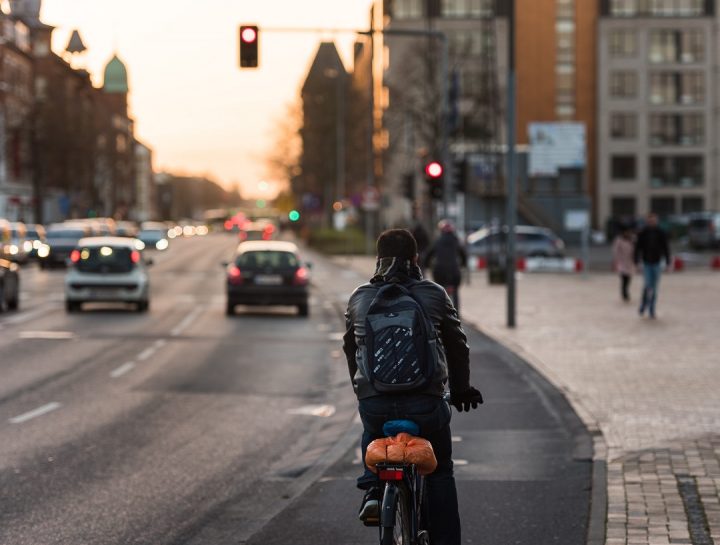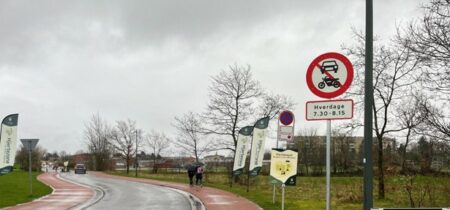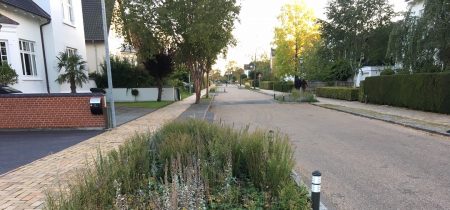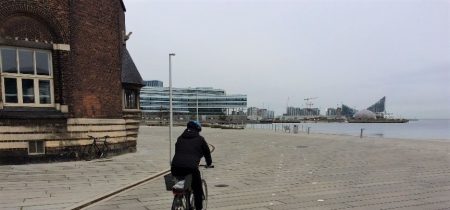Signal controlled intersections – cycle friendly solutions
There are a number of detail solutions that make life easier for cyclists and that are particularly useful at signal controlled intersections. Happy cyclists bike more. There are approved standard solutions as well as solutions that require dispensation from the Danish Road Directorate.
By Troels Andersen
Cyclists can ride around the traffic signal at T- intersections
At signal controlled T- intersections with a cycle track up to and through the intersection and set- back stop lines for cars, planners can choose to allow cyclists going straight ahead to drive around the traffic light. The number of stops the cyclist has to make is reduced and accessibility increased. If the signal stand is not to the left of cyclists going straight ahead, a cyclists excepted sign may be placed on the lower part of the stand.
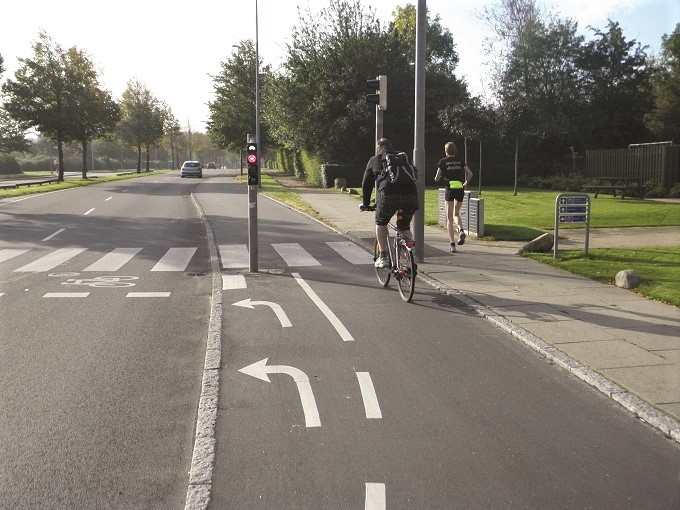
- There is a separate left- turn phase for turning cyclists, while cyclists going straight ahead merely observe the right of way at the intersection. Photo: Troels Andersen
The measure can be combined with a left turn lane for cyclists. Cyclists must give way to crossing pedestrians in a pedestrian crossing so the solution is most suitable in areas where there are not many crossing pedestrians. Another possibility is a traffic island between the cycle track and the traffic lane to emphasize that different right of way rules apply: signal vs pedestrian crossing. The island may also make it possible to remove the pedestrian crossing from the cycle track.
It’s important that cyclists can see pedestrians that are crossing in front of them. It may be a good idea to set the stop line for cars 5 m back in order to improve the field of vision.
The number of accidents is the same.
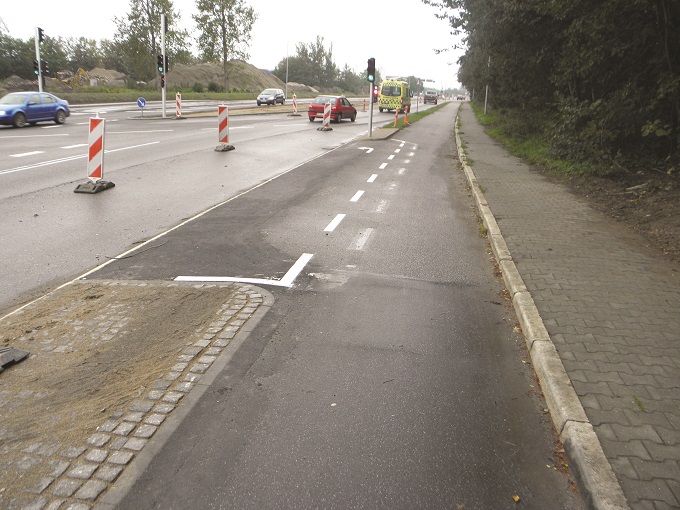
- Cyclists going straight ahead ride around the signal, and left turning cyclists have their own lane. Photo: Troels Andersen.
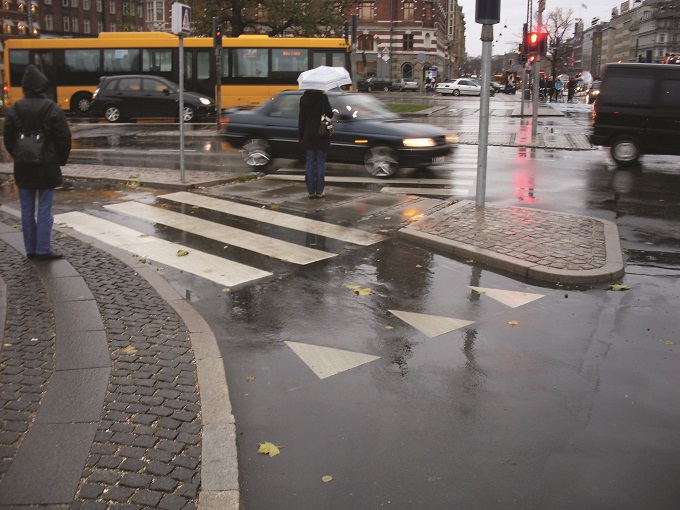
- Cyclists have a slip lane to the right of the signal. Photo: Troels Andersen
Right-turn shunt for cyclists
At signal controlled intersections with enough space, a right- turn shunt behind the signal control can be established, i.e. a right slip lane. Right- turn cyclists then don’t have to stop on red. The solution is very popular among cyclists, but not always so popular among pedestrians. For this reason it’s best to use it in areas with small pedestrian flow.
The number of accidents is unchanged.
This solution is fairly wide spread in Odense, approx. 90 in all.
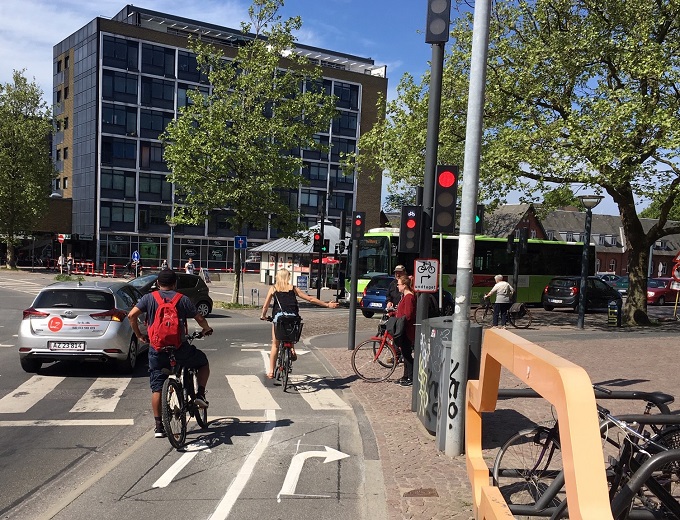
- Right turn on red for cyclists is a popular solution. Photo Troels Andersen
Right turn on red for cyclists
Danish studies show that around half the right turning cyclists that arrive at the intersection while the traffic light is red turn right through the red light. By changing the signage and marking, cyclists can be allowed to turn right on red. The solution makes it clear to drivers that they must yield to the remaining cyclists who cross on the green light.
The number of accidents is unchanged.
The Danish Road Directorate requirement is that the cycle track should be divided into a straight ahead lane and a right- turn lane with a total width of at least 1.85 m incl. solid cycle track divider line. There must also be a cycle track when leaving the intersection.
This solution is most widespread in Odense with 38 examples.

- Cycle pocket in front of right turn lane. Photo: Troels Andersen
Cycle pockets
Cycle pockets can be installed at signal controlled intersections by painting the bicycle symbol in front of the stop line for motor vehicles in turn lanes. This allows cyclists to wait for the light in front of cars. The advantage is that cyclists waiting for the light to change are more visible to turning cars, and that cyclists enter the intersection before cars.
Cycle pockets in front of left turn lanes may only be marked on side roads at signal controlled T-intersections, not four legged intersections.
A study of left turning cyclists in cycle pockets in Copenhagen showed that cycle pockets make cyclists feel more secure and satisfied. All the cyclists questioned stated that the cycle pocket makes them more visible to drivers and that the bicycle pocket makes it easier for them to move forward.
However, planners should be careful about using bicycle pockets where there are many large heavy vehicles. A lorry driver cannot necessarily see a cyclist standing right in front of the lorry.
Cyclist railings
A cyclist railing can be placed along the cycle track just before the stop line for the cyclist to lean on. The cyclist can place either a hand or a foot on the railing. 40% of cyclists use the railing and railings result in a slight drop in the number of cyclists crossing against the light.
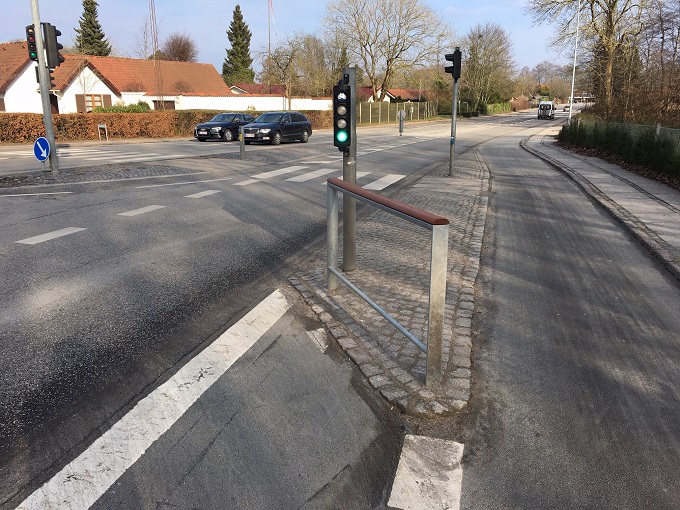
- A cyclist railing makes waiting easier and reduces the number of cyclists who cross against the light. Photo: Troels Andersen
Rush hour intersections for cyclists
Rush hour intersections are used in Holland during rush hours when cyclists from all directions have a joint phase, often twice per circuit. Then when motor vehicles have the green light, all cyclists are held back. The aim is to separate cyclists from motorists in time and thus prevent accidents. If cyclists have two phases per circuit their accessibility is significantly increased. On the other hand cyclists have to keep an eye on each other. This improves cyclist accessibility without affecting traffic safety.
Herning municipality initiated a pilot project at the intersection Sjællandsgade/HC. Ørstedsvej in 2013. The project showed that the rush hour phase ensured that cyclists were separated in time from other traffic streams in the intersection. The risk of accident was not eliminated, however, since there were cyclists who continued to cross on the main signal and a small share of drivers who crossed on the green cyclist signal. In an interview survey 20% of the cyclists questioned responded that they had experienced conflicts and near accidents during the intersection test project.
All in all, experience shows that establishing a rush hour phase at the intersection had a positive safety effect.
However, other intersections may give different results since everything depends on whether or not road users recognize and respect the signal control. The rules must be made extremely clear. Since this is completely new in Denmark it will take a long time for road users to become accustomed to it. It might not be a bad idea to establish this type of intersection at different locations in the same city so road users can learn the correct behaviour more quickly.
See the video of the opening here.
Warning cyclists about right turning lorries
Tests have been carried out warning cyclists electronically of right turning traffic ahead, especially lorries. A project in Aarhus has shown positive trends, but the actual effect on traffic safety remains uncertain.
The results were:
- The number of conflict situations between cyclists and lorries fell.
- The share of cyclists looking left increased.
- Fewer cyclists braked or slowly slipped forward.
- Fewer cyclists increased speed or used their pedals.
- 86% of cyclists prefer riding through the intersection with the variable message sign.
- 40% think that fewer dangerous situations arise, 1% think more do.
- The sign’s function should be made extremely clear.
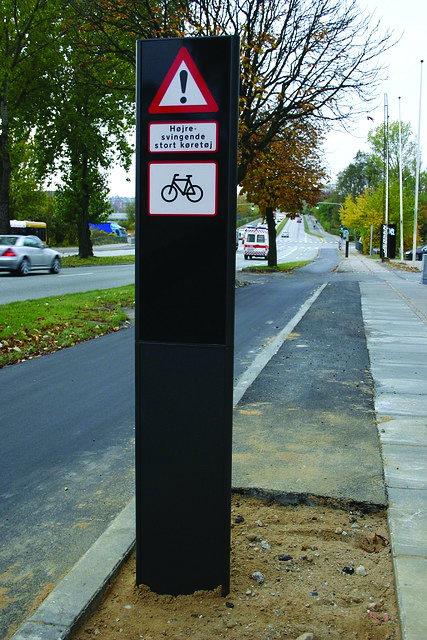
- The sign lights up a warning to cyclists before they risk meeting a right turning lorry at the traffic light. Photo: Aarhus municipality
See how the solution works here: https://vimeo.com/7922372
There are other solutions where cyclists ride with warning lights themselves: https://youtu.be/ix2sNGhXJ2c
It is crucial that all warning measures are supportive, and that cyclists and right turning vehicles are not deprived of their normal responsibility to be attentive and alert. Technology can always crash!
Sources
Herning trafiksikkerhedsby – hvad fik vi ud af det?, Trafik & Veje, november 2016
Effektevaluering af venstresvingsbokse for cyklister, Trafik & Veje, maj 2018
Cyklister i kryds, Trafik & Veje, oktober 2004
Bløde trafikanter uden om signal i lyskryds, Trafik & Veje, november 2014


